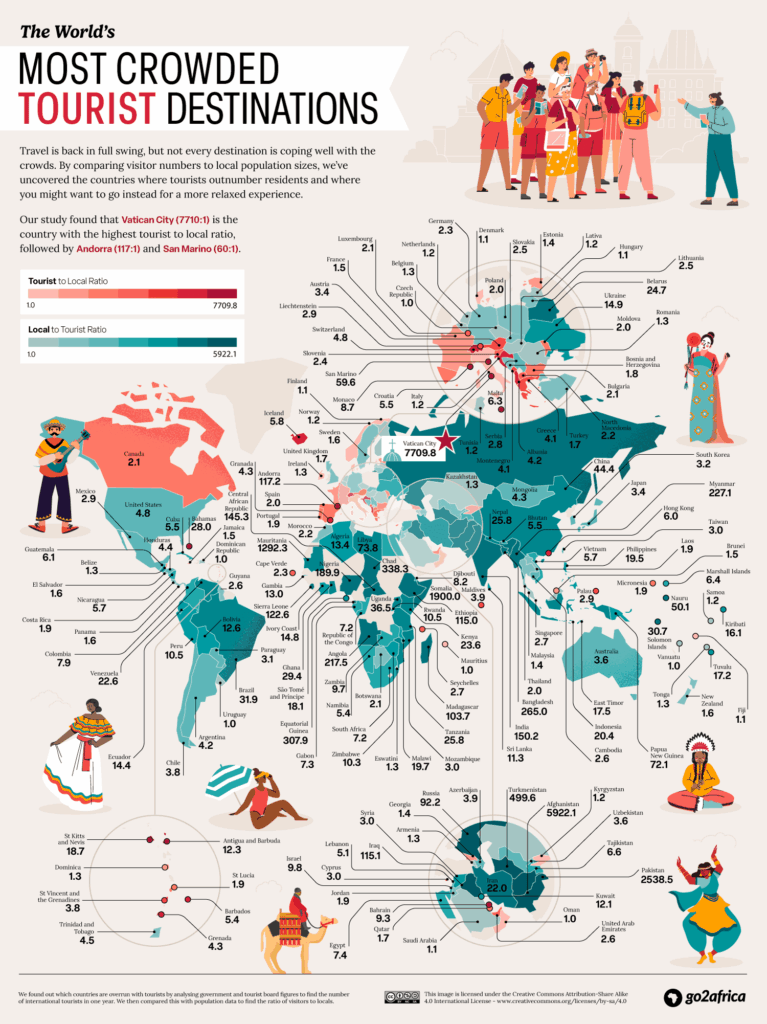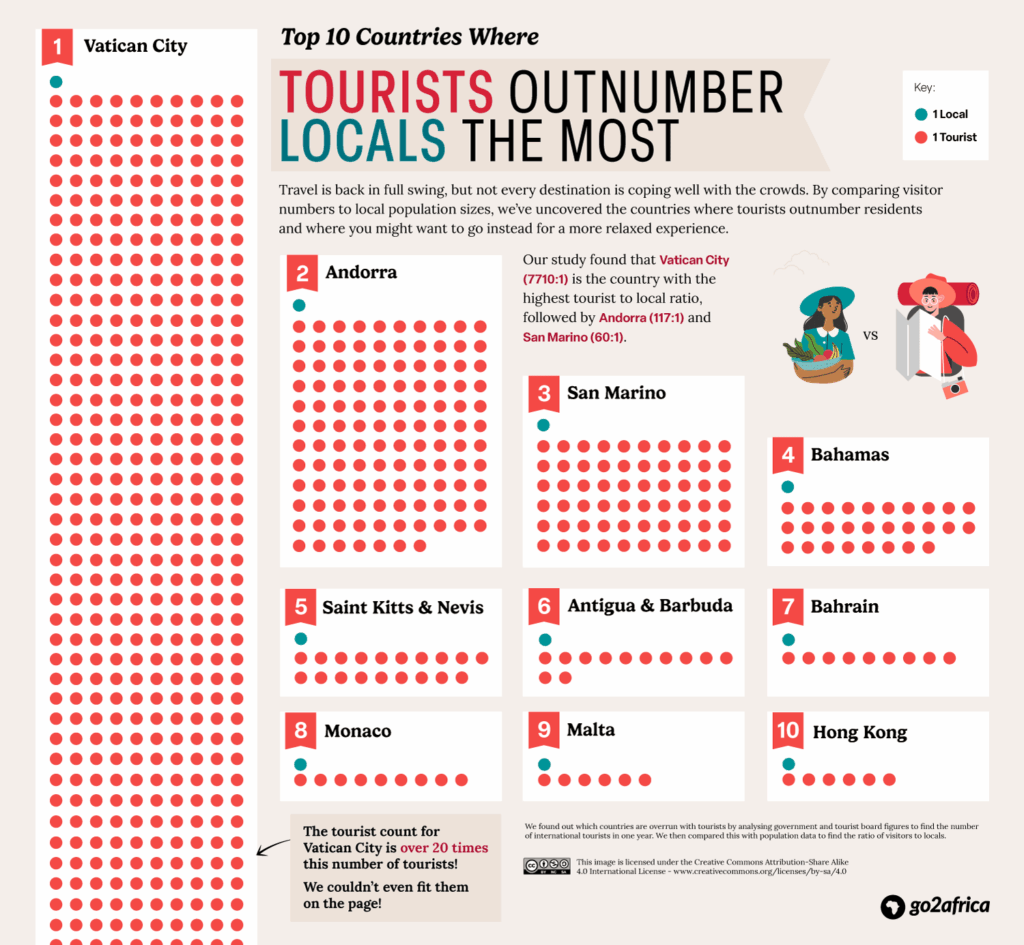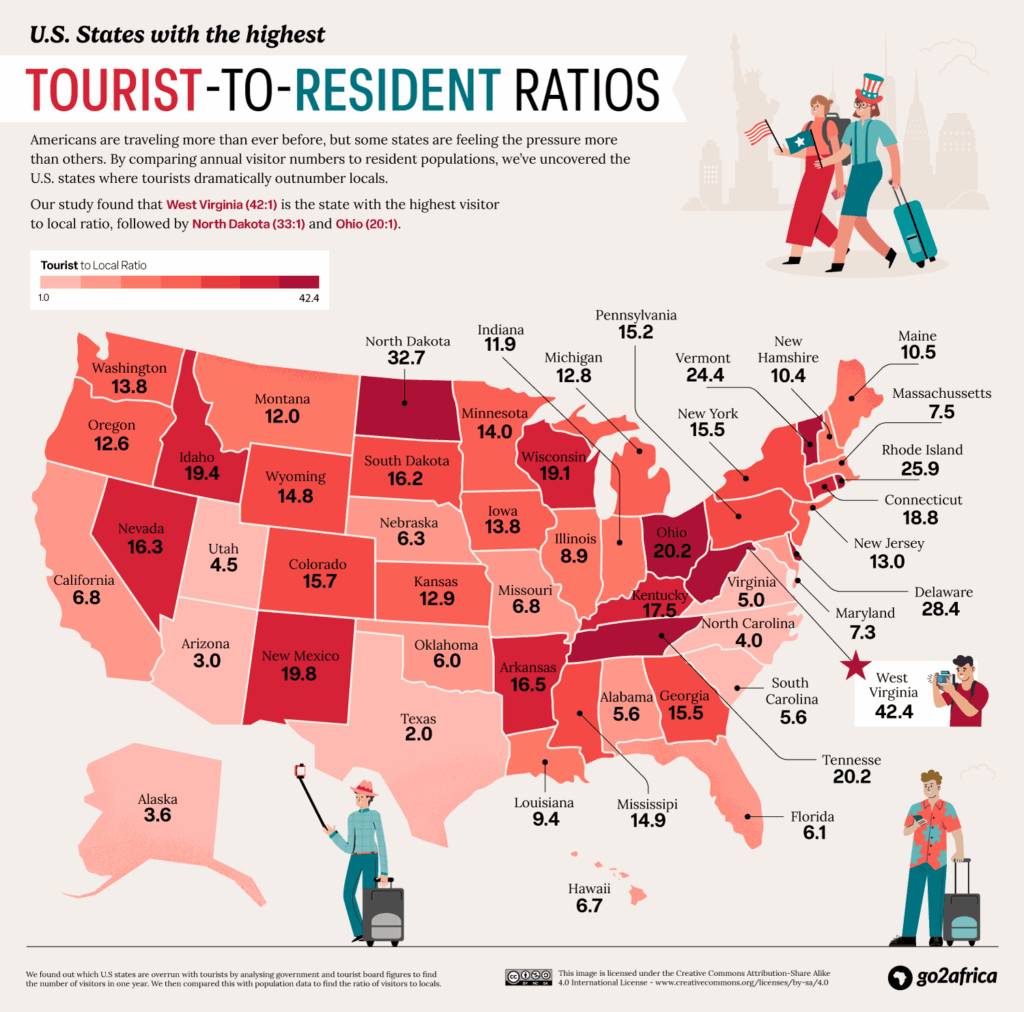Language
- English
- Español
Currency
- AUD Australian Dollar
- CAD Canadian Dollar
- EUR Euro
- GBP Pound Sterling
- USD US Dollar
- ZAR Rand

With travel back in full swing, many of the world's most popular destinations are now welcoming more visitors than ever before. An estimated 1.4 billion tourists travelled internationally in 2024, marking a near-complete recovery (99%) to pre-pandemic levels.
But as millions of tourists return to globetrotting, the surge in tourism is starting to strain some destinations.
Some places, like iconic European cities, have become so crowded that tourists actually outnumber the people who live there. Others manage to strike a healthy balance between visitors and locals, offering a more genuine and relaxed experience. As a result, more travelers are seeking unique, off-the-beaten-path destinations away from the usual tourist crowds.
We curate unforgettable nature-based African safaris, shaped by over 25 years of experience and deep local connections. With every adventure designed to leave a lasting impact – on our travellers, the land, and the local communities who call it home.
So, our data team set out to investigate: which countries and U.S. states are the most overrun by tourists? Using the latest official tourism data, we reveal the most crowded destinations and where you might go instead.
To conduct the study, Go2Africa gathered official tourism figures from national tourist boards and reports to determine the number of visitors to each country and U.S. state. These figures were then compared to the population data for the same year, allowing the team to calculate the ratio of tourists to local residents for each location.
With international travel back in full swing, global tourism surged in 2024. From iconic cities to cultural capitals, some destinations continue to attract millions of visitors each year. Below, we take a look at the most visited countries in the world and what's driving the influx of visitors.
France retained its title as the world's most visited country, attracting over 100 million international tourists in 2024. Long celebrated for its cuisine, art, and architecture, France saw an extra boost this year as Paris hosted the Olympics, drawing more than 11.2 million visitors to the capital alone.
Spain followed closely with 94 million visitors to the country, thanks to its sun-soaked coastlines, rich history, and vibrant cities. However, growing tensions between locals and tourists, especially in Barcelona, the epicenter of recent anti-tourism protests, have started to shift public sentiment.
The United States finds itself in third place with 72 million international tourists in 2024. As well as being one of the largest countries in the world, this popularity is driven by its diverse attractions, from iconic cities like New York and Los Angeles to natural wonders such as the Grand Canyon and Yellowstone National Park. With something for every kind of traveler, from adventure-seekers to culture lovers, the U.S. remains a global tourism heavyweight.
| The Countries With the Most International Tourism | ||
| Ranking | Country | Number of Tourists |
| 1 | France | 100,000,000 |
| 2 | Spain | 94,000,000 |
| 3 | United States | 72,390,321 |
| 4 | Italy | 68,487,423 |
| 5 | Turkey | 52,600,000 |
| 6 | Mexico | 45,040,000 |
| 7 | Hong Kong | 44,500,000 |
| 8 | United Kingdom | 41,200,000 |
| 9 | Greece | 40,700,000 |
| 10 | Japan | 36,870,000 |
| 11 | Thailand | 35,540,000 |
| 12 | China | 32,000,000 |
| 13 | Austria | 30,900,000 |
| 14 | Saudi Arabia | 30,000,000 |
| 15 | United Arab Emirates | 28,150,000 |
Although the total number of international visitors to a country gives us a good indication of which areas are the busiest, comparing these numbers with the population figures of a location gives us a better idea of where tourism might be overcrowding local areas.
The study reveals that the most overcrowded countries are typically located in or near Southern and Western Europe, where seamless cross-border travel within the Schengen Zone makes tourism highly accessible. Similarly, many are Caribbean island nations, which attract heavy cruise ship traffic, often welcoming thousands of visitors per day.

According to the study, Vatican City ranks as the most overcrowded tourist destination, with an incredible 7,709 tourists to ever resident. While this ratio is extreme, it comes with context: Vatican City, based within Rome is just 0.44 square kilometers in size and is a place of pilgrimage and cultural significance for many people around the world. Its tiny population of 882 consists mainly of clergy, diplomats, and officials, making it unlike any typical country.
Coming in second place is Andorra, which welcomed 9.6 million visitors in 2024, compared to just 81,938 locals. This gives the microstate a ratio of 117 tourists per resident. Nestled between France and Spain, Andorra is best known for its luxury ski resorts and status as a tax haven, all of which contribute to its outsized appeal.
Many of the most overcrowded destinations are also small island nations, particularly popular among cruise travelers. These places often experience massive, short-term surges in visitors, which can strain local infrastructure and negatively impact local communities. Countries like San Marino, the Bahamas, Saint Kitts and Nevis, and Antigua and Barbuda all experience heavy cruise traffic, often receiving more visitors in a day than they have locals.
These figures highlight the growing tension between tourism and sustainability, reminding us why it's important to find a balance that keeps both visitors and locals happy while preserving what makes these destinations special.

It's not just entire countries feeling the pressure of tourism, many U.S. states are also seeing visitor numbers soar well beyond their local populations. This can mean crowded attractions, increased pressure on local infrastructure, and rising tensions between residents and tourists, especially in places where tourism drives the local economy.
Every state in this study hosts more visitors annually than residents,though some see far higher ratios than others. Check out the map below to discover which states have the biggest visitor-to-local imbalances.

Every year, West Virginia welcomes an impressive 75 million visitors, both international and domestic, compared to just 1.77 million residents. That's more than 42 visitors for every local, making it the most overcrowded state in the country. Known for its outdoor adventures like hiking, whitewater rafting, and rock climbing, West Virginia's natural appeal draws travelers year-round.
Meanwhile, New York boasts the highest total tourism numbers, with 306 million visitors annually. This is largely driven by New York City, one of the world's top tourist destinations, attracting both international and domestic travelers. Following closely is California, with 264 million tourists each year, drawn by the glamor of Hollywood, beaches of Los Angeles and natural wonders like Yosemite, Big Sur, and the Redwood Forests.
On the other end of the spectrum, Texas experiences the lowest visitor-to-local ratio, with just 2 visitors for every resident. Its geography, far from the typical East-West coastal routes favored by international tourists and its large population of over 31 million help keep tourism more balanced.
Alaska ranks as the least visited state overall, with just 2.7 million visitors a year. Despite its breathtaking landscapes of glaciers, mountains, wildlife, and the Northern Lights, its remote location and limited accessibility mean fewer travelers make the journey. Reaching Alaska typically requires costly flights or cruises, often limited to certain seasons.
Popular tourist hotspots can offer incredible experiences but their overwhelming crowds can sometimes take away from the magic. Quieter alternatives provide a more relaxed and authentic experience. Below are some of the world's most visited destinations paired with nearby or similar “dupe” locations where you can enjoy the highlights with fewer tourists.
Vatican City is one of the most visited religious and historical sites in the world, attracting millions of tourists despite its tiny size. Its immense crowds can sometimes overwhelm visitors seeking a quieter, more reflective experience. For those looking to soak up medieval charm without the crush of tourists, Siena, Italy offers stunning Gothic architecture, peaceful piazzas, and important religious landmarks, all set in the heart of the Tuscan countryside.
Andorra is famed for its ski resorts, mountainous terrain, and status as a tax haven, drawing large numbers of visitors during winter seasons. If you want similar alpine beauty and world-class skiing but with fewer crowds, the Slovenian Alps offer breathtaking scenery, charming mountain villages, and quieter slopes that are perfect for a more relaxed getaway.
If you're dreaming of the Antigua and Barbudas but looking for a quieter alternative, Seychelles makes for a compelling dupe. Both are made up of multiple picture-perfect islands fringed by white-sand beaches and turquoise waters. But while Antigua and Barbuda are firmly on the Caribbean cruise and resort circuit, Seychelles feels more off-grid, with fewer visitors, more protected nature reserves, and a greater sense of seclusion. Seychelles is globally recognised for its commitment to conservation with over 40% of its land is under formal protection, including UNESCO-listed sites like the Vallée de Mai and the Aldabra Atoll, home to rare species like the coco de mer palm and giant tortoises.
For those who love the vibrant energy and cultural fusion of Hong Kong but want to escape the relentless crowds and frantic pace, South Africa offers a less hectic alternative. Both destinations boast beautiful hikes, pristine urban beaches, and nearby nature reserves, but South Africa's vast landscapes provide more space and tranquility. Whether it's hiking Table Mountain instead of Dragon's Back or enjoying uncrowded beaches along the Garden Route, South Africa delivers a similar mix of city life and nature. While the food is vastly different, both countries lead in their culinary delights with South Africa boasting some of the best wine and gastronomy in the world.
Monaco attracts luxury travelers to its famous casinos, yachts, and Mediterranean coastline, but the city-state is often packed with visitors. For a luxurious coastal experience with fewer people, Rovinj on Croatia's Adriatic coast combines charming old town streets, upscale dining, and beautiful seaside views without the crowds.
Both island nations boast diverse cultural influences, from colonial European legacies to African and Asian heritage, and both offer a rich mix of architecture, language, and cuisine. But where Malta can feel densely built and distinctly Mediterranean, Mauritius delivers that same cultural complexity in a more lush, spacious, and resort-driven environment with its Indian temples, French colonial buildings, sugarcane fields, and volcanic peaks.
Croatia is known for its stunning Adriatic coast, historic towns, and beautiful beaches, but places like Dubrovnik have become very busy. Just south, Montenegro offers comparable coastal charm with fewer visitors, featuring medieval towns, pristine nature, and clear waters in a more relaxed setting.
West Virginia is known for its misty mountains, forest trails, and small-town charm, a haven for hikers and nature lovers. For a similar vibe with a wilder, more off-the-radar feel, Zimbabwe's Eastern Highlands deliver. This mountainous region along the Mozambique border offers rolling hills, ancient forests, and dramatic waterfalls, all with fewer tourists and more open space. Whether you’re trekking through the Bvumba Mountains or exploring Nyanga National Park, the Eastern Highlands offer that same deep connection to nature, just with more solitude.
While millions flock to the same crowded cities year after year, Go2Africa offers a different path, one that trades queues and crowds for untamed landscapes, raw beauty, and deeply personal encounters with nature and culture. Your greatest adventure.
Our curated safaris and tailored trips take you far beyond the usual tourist trail into Africa's most extraordinary, less-traveled destinations. Whether it's witnessing the Great Migration in a private conservancy, tracking rhinos on foot with expert guides, or sleeping under the stars in Namibia's vast deserts, Go2Africa designs journeys where the only crowd is a herd of elephants.
Beat the crowds and explore Go2Africa's range of safaris.
To find out which cities, states, and countries have more tourists than locals, Go2Africa collected the most recent data available from official sources like tourism boards and international organizations. We focused on visitor numbers from 2024 and 2023 when this was not available, and gathered population figures from the same period to make accurate comparisons.
For each location, we then calculated the ratio of tourists to locals by dividing the number of visitors by the number of residents. This ratio highlights places where tourists greatly outnumber the local population.
We looked specifically at international tourists to understand the impact of visitors coming from outside each country. This helps show where international travel is causing the biggest overcrowding problem. We also looked at U.S. states where we took into account both international and domestic tourists.
The data was collected in June 2025.